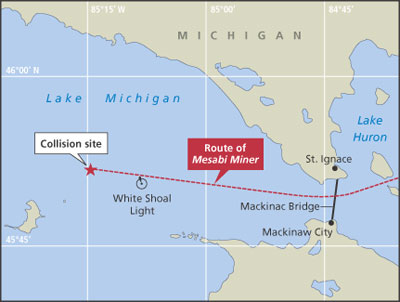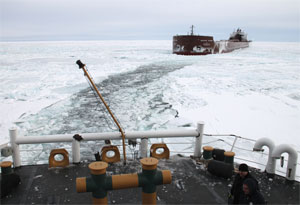The lack of effective communication between the bridge teams on a Coast Guard cutter and bulk carrier led to a collision during icebreaking operations on Lake Michigan, the National Transportation Safety Board (NTSB) has determined. Both vessels sustained significant damage but were able to continue to port.
The 225-foot Hollyhock was leading Mesabi Miner and five other merchant ships west of the Straits of Mackinac on Jan. 5, 2014, when the cutter encountered thick ice and had difficulty continuing forward. The 1,004-foot bulk carrier, the first ship behind Hollyhock in the westbound convoy, was unable to slow quickly enough and struck the stern of the cutter at 1042, the NTSB reported.
Mesabi Miner’s log states that the ship, carrying 49,000 tons of taconite pellets, became beset in the ice at several points on its voyage from Two Harbors, Minn., to Gary, Ind. After passing under the Mackinac Bridge on Jan. 3, the bulker got stuck about six miles east of White Shoal Light. It remained there until Hollyhock organized the convoy on the morning of Jan. 5.
Hollyhock’s officer of the deck (OOD) instructed the first four vessels in the lineup — Mesabi Miner, Arthur M. Anderson, Stewart J. Cort and Hon. James L. Oberstar — that he intended to proceed at 8 to 10 knots. He stated that the lead ship should stay about 1,000 yards astern of the cutter, and that the navigational team on each of the other vessels was responsible for maintaining a safe distance from the ship ahead. Indiana Harbor and Joyce L. Van Enkevort joined the convoy shortly afterward.
After getting up to speed, Mesabi Miner stayed 800 to 1,200 yards behind Hollyhock. The mate on watch aboard the bulker estimated it was traveling 6 to 8.5 knots. Visibility was nine miles under cloudy skies.
During interviews after the collision, Hollyhock’s commanding officer and the master of Mesabi Miner described a “fluid operation” demanding close cooperation in coordinating speeds and distances.
“Both felt comfortable with the scenario that day and agreed nothing seemed out of the ordinary or extreme about the day’s icebreaking operations,” the NTSB report stated.
Hollyhock led the six vessels along a track the icebreaker had established several days earlier. The conditions included refrozen 6- to 8-inch-thick accumulations known as brash ice.
At about 1025, Hollyhock’s commanding officer and executive officer left the bridge. At 1039, the cutter entered an area where the ice appeared thicker, with several brash piles. Hollyhock’s speed was reduced to 3.4 knots and the OOD contacted Mesabi Miner to ask that its speed also be reduced. The bulker’s bridge acknowledged and the master reported bringing both main engines to zero pitch.
Hollyhock’s OOD increased the throttle to full power just before the cutter struck ice that brought it to a stop. The OOD radioed Mesabi Miner to report that Hollyhock was beset, but he did not recall hearing an immediate acknowledgment, the NTSB report stated. The bulker’s third mate alerted the master about Hollyhock’s situation and he placed both engine controls in full astern.
Mesabi Miner’s master and mate told the NTSB they did not hear a second message from Hollyhock informing them it had stopped due to the ice. Crewmembers from another vessel in the convoy confirmed to investigators that Hollyhock’s crew did make a second radio call.
At 1040, Hollyhock’s commanding officer assumed control from the OOD and issued an order to back and ram the ice patch. The crew on the cutter stated that they informed Mesabi Miner of this action via radio. The ramming maneuver was unsuccessful, and when Mesabi Miner closed to within 465 yards at 7.1 knots, Hollyhock’s commanding officer determined that a collision was imminent.
“Although the Hollyhock’s throttle was at full ahead, the cutter was nearly stationary when the commanding officer ordered left full rudder to direct the vessel outward and to the port side of the Mesabi Miner on contact,” the NTSB report stated. “He then directed the crew to sound the vessel’s collision alarm.”
 |
|
The laker Mesabi Miner was part of a convoy when it collided with the Coast Guard buoy tender Hollyhock in Lake Michigan. The laker was the lead ship behind the Coast Guard vessel, which was breaking ice near the Straits of Mackinac. |
|
Pat Rossi illustration/Source:NTSB |
About 15 seconds later, at 1042, the bow of Mesabi Miner struck the stern of Hollyhock, freeing the cutter from the ice patch.
Hollyhock sustained damage to structural framing at the stern and port quarter in the steering gear room, aft laundry, stern thruster space, fantail and railing. It sustained two small punctures about 20 feet above the waterline. The cutter was removed from icebreaking duties while repairs were completed.
Mesabi Miner, owned and operated by Interlake Steamship Co., sustained damage that included the indentation of the bow hull plate, distortion of internal framing in the forepeak, minor buckling of the forward main deck and a 12-inch crack about 4 feet above the waterline. Repairs were estimated at $250,000.
In its report, the NTSB cited the lack of a Coast Guard procedure for confirming and acknowledging radio calls during icebreaking operations, stating that it “could have improved the effectiveness of communications among all vessels in the convoy, particularly when standard minimum distances could not be maintained due to the nature of the icebreaking.” Investigators also noted the following:
• Hollyhock’s crew did not ask for the “particulars” of the six vessels in the convoy, including the stopping distance and turning radius, because they believed they were familiar with each ship’s characteristics.
• An amber light that indicates when the cutter is operating astern during icebreaking was not in use at the time of the collision. Officers decided not to use the light because vessels being escorted during the previous week reported difficulty seeing it.
• Hollyhock’s crew did not pass along emergency maneuvering information, including the expectation that the cutter would turn to starboard and the vessel following would turn to port. The commanding officer stated he did not want to confuse the ships in the convoy about which direction each would be required to turn. He stated that he did not have full confidence in the evasive maneuvers because ice conditions did not always allow ships to turn in the predetermined direction.
In response to the incident, the Coast Guard’s 9th District conducted its own investigation and implemented new policies for icebreaking on the Great Lakes, spokesman Lorne Thomas told Professional Mariner. The changes include:
• Establishing communication requirements during escorts, including discussion of emergency maneuvering, for “continuous awareness” of an escorted vessel’s following distance.
• Accounting for technical inconsistencies in positioning equipment that might provide misleading data on the distance between vessels.
• Conducting an annual “safety stand down” for cutter crews to review policies, best practices and lessons learned before the start of each icebreaking season.
• Incorporating a review of each cutter’s icebreaking procedures, checklists and safety guidance into the annual “Ready for Operations” examination.
• Identifying and incorporating a more effective visual signal than what is currently in use.
“Additionally, we reviewed the performance of the Hollyhock’s commanding officer and navigation team and found the commanding officer fit to retain command,” Thomas said.
NTSB investigators found that Interlake Steamship had no specific written procedures for convoy ice operations. Instead, the practice “had been handed down by experienced operators, from master to junior officers, basically as on-the-job training,” the report stated.
Tom Wynne, general counsel for Ohio-based Interlake, said there has been discussion at the company about the Mesabi Miner incident but that no written guidelines have been put in place.
“The reason is because (icebreaking) is such a dynamic situation,” he said. “Every time they’re in ice ops, it’s different. The conditions are different, the situation is different, the location is different. If you’re going to put a written procedure in, it would simply say follow the order of the Coast Guard. It’s hard to put into writing something that would cover all of those dynamic situations.”
Wynne praised the NTSB report and said investigators “came to the natural and logical conclusion” that if communication is improved, the risk of a collision is reduced. But he said in the case of Mesabi Miner and Hollyhock, it likely would not have mattered.
The folks on our ship didn’t hear one of the radio calls that the Coast Guard apparently made, but it didn’t make a difference because we had a captain and mate who were both very attuned to what was going on,” Wynne said. “The mate was watching the radar and the electronic equipment on the bridge. He was able to realize immediately when Hollyhock slowed down, and that set into the motion the captain’s actions, which resulted in him basically pulling the sticks back to zero pitch and right through to full astern. So there was really no delay on that. Whether they heard the radio call or not, I don’t think that would have changed the actions on the bridge of Mesabi Miner.”

